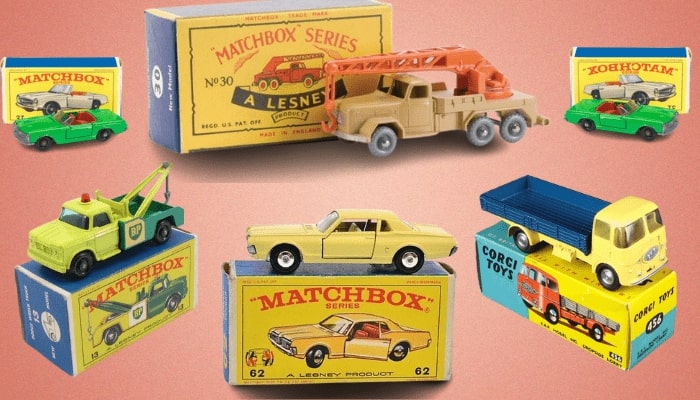When Tiny Wheels Tell Massive Stories
Let me take you on a journey that began for me decades ago – a world where miniature die-cast vehicles aren‘t just toys, but living historical artifacts that capture the essence of automotive design, manufacturing innovation, and human nostalgia.
The Birth of a Collecting Passion
Picture a small workshop in post-war London, 1953. Two friends, Jack Odell and Leslie Smith, never imagined they would revolutionize the world of toy manufacturing. Their company, Lesney Products, would become synonymous with miniature automotive excellence.
The origin story is almost mythical. A young schoolgirl told Odell that she could only bring toys to school if they fit inside a matchbox. That simple conversation sparked an idea that would transform the toy industry forever. The first Matchbox car – a modest road roller – was born from this constraint, measuring precisely to fit within a matchbox.
The Manufacturing Marvel
What made Matchbox cars extraordinary wasn‘t just their size, but their incredible attention to detail. Each miniature was a precise replica, crafted with die-casting techniques that were cutting-edge for their time. Zinc alloy molded with incredible precision, hand-painted with meticulous care – these weren‘t just toys, but miniature works of industrial art.
The Collector‘s Ecosystem: More Than Just Acquisition
Collecting Matchbox cars isn‘t merely about accumulating objects. It‘s about preserving moments in automotive and manufacturing history. Each car represents a snapshot of design philosophy, technological capability, and cultural zeitgeist.
Rarity: The Ultimate Valuation Factor
Not all Matchbox cars are created equal. Some models transcend their original purpose, becoming rare treasures that command astronomical prices. Take, for instance, the Matchbox Major Scale Quarry Truck from 1955. With only six known examples worldwide, a single specimen can fetch upwards of $25,000.
What transforms a $.50 toy into a $25,000 collector‘s item? It‘s a complex alchemy of factors:
- Production Limitations
- Manufacturing Anomalies
- Preservation Quality
- Historical Significance
The Most Coveted Matchbox Cars: A Detailed Exploration
The Magirus-Deutz Crane: A Collector‘s Holy Grail
Imagine a pre-production model from 1961, painted in a unique light brown that was never intended for mass production. This Magirus-Deutz Crane represents the pinnacle of collector‘s dreams. Its estimated value of $18,000 isn‘t just about the metal and paint, but the story it tells.
The crane wasn‘t just a toy – it was a miniature engineering marvel. Each detail meticulously crafted, reflecting the actual vehicle‘s design with microscopic precision. Collectors don‘t just see a toy; they see a historical document.
The Opel Diplomat: A Seafoam Green Symphony
In the realm of Matchbox collecting, color can be everything. The Opel Diplomat in seafoam green from 1966-1970 is a perfect example. Most models were produced in standard colors, but this variant represents a manufacturing moment – a color experiment that became legendary.
With an estimated value of $12,500, this car isn‘t just a collectible. It‘s a testament to the experimental spirit of mid-20th-century manufacturing.
Preservation: The Collector‘s Sacred Responsibility
Maintaining these miniature treasures requires more than casual care. It demands a scientific approach:
Temperature-controlled environments
Specialized display cases
Minimal handling
Detailed documentation
Each car is a fragile historical artifact. One mishandled movement can dramatically reduce its value.
The Investment Potential
While passion drives most collectors, the financial aspect cannot be ignored. Matchbox cars have consistently demonstrated impressive appreciation. Unlike many collectibles, these miniatures represent a tangible connection to automotive history.
Market Dynamics
The collector‘s market is global and dynamic. What‘s valuable today might change tomorrow. Emerging markets in Asia and renewed interest from younger generations are reshaping valuation dynamics.
Personal Reflection: Why We Collect
Collecting isn‘t about money. It‘s about connection. Each Matchbox car carries stories – of design, of manufacturing, of childhood memories. When I hold a rare model, I‘m not just holding metal and paint. I‘m holding a piece of human creativity.
Conclusion: A Living Legacy
Matchbox cars are more than collectibles. They‘re time machines, storytellers, and testaments to human ingenuity. Whether you‘re a seasoned collector or a curious enthusiast, these miniature marvels invite you to look closer, to see the extraordinary in the seemingly ordinary.
The journey of collecting is never truly complete. Each discovery opens new chapters, new stories waiting to be told.
